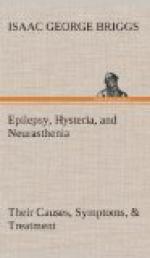Such a patient is often greatly upset by a trifle, yet little affected by a real shock, which by its very severity arouses his reactive faculties which lay dormant and left him at the mercy of the minor event. He will fret over a farthing increase in the price of a loaf, but if his bank fails he sets manfully to.
Duty that should be done to-day he leaves to be shirked to-morrow; he is easily discouraged, timid, and vacillating. Extremely self-conscious, he thinks himself the observed of all observers. If others are indifferent toward him, he is depressed; if interested, they have some deep motive; if grave, he has annoyed them; if gay, they are laughing at him; the truth, that they are minding their own business, never occurs to him, and if it did, the thought that other people were not interested in him, would only vex him.
He is extremely irritable (slight noises make him start violently), childishly unreasonable, wants to be left alone, rejects efforts to rouse him, but is disappointed if such efforts be not made, broods, and fears insanity. The true melancholic is convinced he himself is to blame for his misery; it is a just punishment for some unpardonable sin, and there is no hope for him in this world or the next. The neurasthenic, on the contrary, ascribes his distress to every conceivable cause save his own personal hygienic errors.
A neurasthenic, if epileptic, fears a fit will occur at an untoward moment. He dreads confined or, maybe, open spaces, or being in a crowd. When he reaches an open space (after walking miles through tortuous byways in an endeavour to avoid it) he becomes paralysed by an undefinable fear, and stops, or gets near to the wall.
He fears trains, theatres, churches, social gatherings, or the office.
Other victims fear knives, canals, firearms, gas, high places, and railway tracks, when the basic fear is of suicide. Many patients have sudden impulses—on which the attention is focussed with abnormal intensity—to perform useless, eccentric, or even criminal actions; to count objects, to touch lamp-posts, to continually reiterate certain words, and so on.
The victim is fully aware that there are no grounds for his panic or impulse, but though his reason ridicules, it cannot disperse, his fear, and the wretched man finds relief in sleep alone, which adds to his woes by being a coy lover.
An almost invariable stage is that wherein the patient studies a patent-medicine advertisement and finds that a disease, or collection of diseases, is the root of his troubles. This alarms but interests him; he studies other advertisements, sends for pamphlets, and so becomes familiar with a few medical terms. He then takes a “treatment”, and talks of his “complaint” and how he “diagnosed” it. He has become hypochondriac.
He borrows a book on anatomy from the public library to discover in what part of the body his ailment is located.




